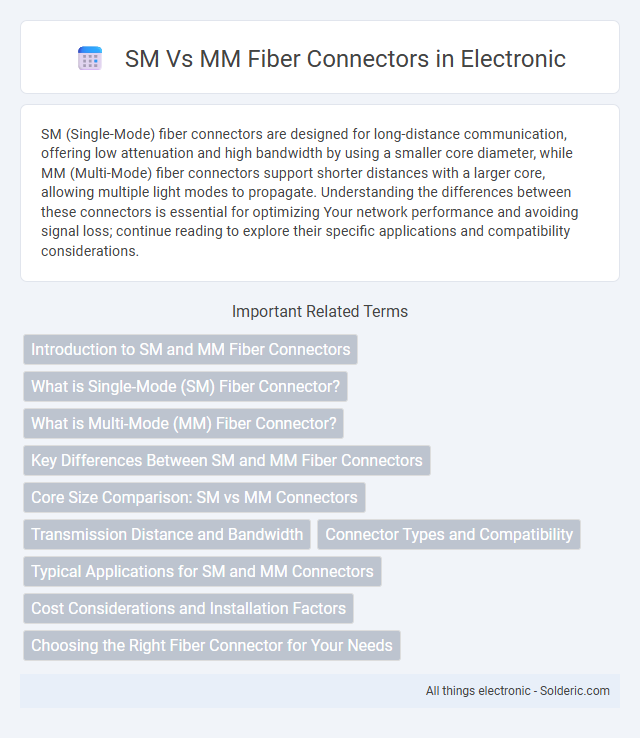SM (Single-Mode) fiber connectors are designed for long-distance communication, offering low attenuation and high bandwidth by using a smaller core diameter, while MM (Multi-Mode) fiber connectors support shorter distances with a larger core, allowing multiple light modes to propagate. Understanding the differences between these connectors is essential for optimizing Your network performance and avoiding signal loss; continue reading to explore their specific applications and compatibility considerations.
Comparison Table
| Feature | Single Mode (SM) Fiber Connectors | Multi Mode (MM) Fiber Connectors |
|---|---|---|
| Core Diameter | 8-10 microns | 50-62.5 microns |
| Light Source | Laser | LED or VCSEL |
| Distance | Up to 40 km or more | Up to 550 meters |
| Bandwidth | Higher (Gbps to Tbps) | Lower (Gbps range) |
| Connector Types | LC, SC, FC, ST | LC, SC, ST |
| Application | Long-distance telecom, data centers | LANs, data centers, short-distance |
| Cost | Higher (due to precision and equipment) | Lower |
| Dispersion | Lower modal dispersion | Higher modal dispersion |
Introduction to SM and MM Fiber Connectors
Single-mode (SM) fiber connectors are designed for long-distance transmission, using a small core diameter around 9 microns to minimize signal loss and maintain high bandwidth over kilometers. Multimode (MM) fiber connectors feature a larger core size, typically 50 or 62.5 microns, optimized for shorter distances and cost-effective data communication within buildings or data centers. Your choice between SM and MM fiber connectors depends on the required transmission distance and network infrastructure.
What is Single-Mode (SM) Fiber Connector?
A Single-Mode (SM) fiber connector is designed for use with single-mode optical fibers, which have a small core diameter of approximately 8 to 10 microns, allowing laser light to transmit signals with minimal modal dispersion over long distances. Common SM fiber connectors include LC, SC, and FC types, optimized for low insertion loss and high return loss to maintain signal integrity in telecommunications and data center networks. These connectors support wavelengths typically around 1310 nm and 1550 nm, providing high-performance connectivity for long-haul fiber optic communication.
What is Multi-Mode (MM) Fiber Connector?
Multi-Mode (MM) fiber connectors are designed to connect multi-mode fiber optic cables, which feature larger core diameters typically around 50 or 62.5 microns to support multiple light modes for short-distance data transmission. These connectors are commonly used in local area networks (LANs), data centers, and enterprise applications where cost-effective, high-bandwidth communication over distances up to 600 meters is required.
Key Differences Between SM and MM Fiber Connectors
Single-mode (SM) fiber connectors are designed for long-distance data transmission with a small core size of about 9 microns, minimizing signal attenuation and allowing higher bandwidth over several kilometers. Multi-mode (MM) fiber connectors feature a larger core size, typically 50 or 62.5 microns, supporting shorter distance communication due to modal dispersion, making them ideal for local area networks. Understanding these key differences ensures your fiber optic setup achieves optimal performance and reliability based on distance and bandwidth requirements.
Core Size Comparison: SM vs MM Connectors
Single-mode (SM) fiber connectors have a core size of approximately 8-10 microns, designed to carry light directly down the fiber with minimal signal loss over long distances. In contrast, multi-mode (MM) fiber connectors feature a larger core size, typically 50 or 62.5 microns, allowing multiple light modes to propagate but limiting transmission distance due to modal dispersion. Understanding your network's distance and bandwidth requirements helps determine whether SM or MM fiber connectors with their respective core sizes are the optimal choice.
Transmission Distance and Bandwidth
Single-mode (SM) fiber connectors support longer transmission distances up to 40 kilometers or more due to their smaller core size, which reduces signal attenuation and dispersion. Multi-mode (MM) fiber connectors offer higher bandwidth over shorter distances, typically up to 600 meters, making them ideal for data centers and local area networks. Choosing the right fiber connector impacts Your network's transmission distance and bandwidth capabilities, optimizing performance based on specific application requirements.
Connector Types and Compatibility
Single-mode (SM) fiber connectors, such as SC, LC, and FC, are designed for long-distance transmissions and often feature physical contact (PC) or angled physical contact (APC) polished end faces to minimize signal loss. Multimode (MM) connectors commonly use SC, LC, or ST types with standard PC polish suited for shorter distances and higher bandwidth over limited lengths. When selecting connectors, ensure compatibility between SM and MM fiber types is maintained to prevent signal degradation, as mixing SM connectors with MM fibers can cause significant connectivity issues in Your optical network.
Typical Applications for SM and MM Connectors
Single-mode (SM) fiber connectors are typically used in long-distance telecommunications, high-speed data networks, and metropolitan area networks due to their low attenuation and high bandwidth capabilities. Multi-mode (MM) fiber connectors are commonly deployed in local area networks (LANs), data centers, and enterprise environments where shorter transmission distances and cost-effective solutions are prioritized. Your choice between SM and MM connectors should align with specific application requirements such as distance, data rate, and budget constraints.
Cost Considerations and Installation Factors
Single-mode (SM) fiber connectors generally cost more than multimode (MM) connectors due to the precision required for alignment and the specialized components used in SM applications. Installation of SM fiber demands higher skill levels and more stringent testing to maintain signal integrity over longer distances, increasing labor costs and time. In contrast, MM fiber connectors are easier to install and maintain, making them a cost-effective choice for shorter-distance, high-bandwidth networks where budget constraints are critical.
Choosing the Right Fiber Connector for Your Needs
Selecting the appropriate fiber connector depends on the type of fiber optic cable--Single Mode (SM) or Multi Mode (MM)--used in your network. SM connectors are optimized for long-distance communication with a smaller core diameter, providing higher bandwidth and reduced signal attenuation. MM connectors suit shorter distances with larger core sizes, making them cost-effective for data centers and enterprise networks requiring high-speed transmission over moderate distances.
SM vs MM fiber connectors Infographic

 solderic.com
solderic.com